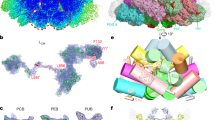Abstract
Phycocyanin is one of the two phycobiliproteins always found in the Phycobilisome antenna complex. It is always situated at the ends of the peripheral rods, adjacent to the core cylinders composed of allophycocyanin. The basic phycocyanin monomer is an (αβ) dimer of globin-like subunits with three covalently linked phycocyanobilin cofactors. Monomers assemble further into trimers, hexamers, and rods which include non-pigmented linker proteins. Upon isolation in low ionic strength solution, rods quickly disintegrate into phycocyanin trimers, which lose contacts with other phycobiliproteins and with the linker proteins. The trimers, however, are quite stable and only the presence of high concentrations of chaotropic agents (such as urea), very acidic solutions, or elevated temperatures induces monomerization, followed by separation between the subunits. We have recently determined the crystal structures of phycocyanin from the thremophilic cyanobacterium Thermosynechococcus vulcanus in the presence of 2 or 4 M urea, and shown that 4 M urea monomerizes the phycocyanin trimers. In this paper, we will describe the phycocyanin structures in 2 and 4 M urea more completely. By mapping out the urea positions, we describe the structural elements within the trimeric interaction interface that may be interrupted by the presence of 4 M urea. In addition, we also identify what are the structural characteristics that prevent 4 M urea from inducing subunit dissociation.





Similar content being viewed by others
Abbreviations
- APC:
-
Allophycocyanin
- GuCl:
-
Gunidinium Hydrochloride
- LP:
-
Linker protein
- PBP:
-
Phycobiliprotein
- PBS:
-
Phycobilisome
- PC:
-
Phycocyanin
- PCB:
-
Phycocyanobilin
- PE:
-
Phycoerythrin
- PEC:
-
Phycoerythrocyanin
- PSII:
-
Photosystem II
- Tv-PBS:
-
T. vulcanus phycobilisome
- Tv-PC-2 MU:
-
T. vulcanus phycocyanin treated with 2 M urea
- Tv-PC-4 MU:
-
T. vulcanus phycocyanin treated with 4 M urea
References
Adir N (2005) Elucidation of the molecular structures of components of the phycobilisome: reconstructing a giant. Photosynth Res 85:15–32
Adir N, Lerner N (2003) The crystal structure of a novel unmethylated form of C-phycocyanin, a possible connector between cores and rods in pycobilisomes. J Biol Chem 278:25926–25932
Adir N, Dines M, Klartag M, McGregor A, Melamed-Frank M (2006) Assembly and disassembly of phycobilisomes. In: Shively JM (ed) Microbiology monographs: inclusions in prokaryotes, vol 2. Springer, Berlin, pp 47–77
David L, Marx A, Adir N (2011) High-resolution crystal structures of trimeric and rod phycocyanin. J Mol Biol 405:201–213
Emseley P, Cowtan K (2004) Coot: model-building tools for molecular graphics. Acta Crystallogr 60:2126-2132
Erokhina LG, Krasnovskii AA (1971) The effects of denaturing agents on the spectral properties of phycocyanin. Mol Biol 5:319–326
Gantt E, Lipschultz CA (1972) Phycobilisomes of Porphyridium cruentum. I. Isolation. J Cell Biol 54:313–324
Glazer AN (1989) Light guides. Directional energy transfer in a photosynthetic antenna. J Biol Chem 264:1–4
Kupka M, Scheer H (2008) Unfolding of C-phycocyanin followed by loss of non-covalent chromophore-protein interactions 1. Equilibrium experiments. Biochim Biophys Acta 1777:94–103
Liu LN, Chen XL, Zhang YZ, Zhou BC (2005) Characterization, structure and function of linker polypeptides in phycobilisomes of cyanobacteria and red algae: an overview. Biochim Biophys Acta 1708:133–142
MacColl R (1998) Cyanobacterial phycobilisomes. J Struct Biol 124:311–334
Marx A, Adir N (2013) Allophycocyanin and phycocyanin crystal structures reveal facets of phycobilisome assembly. Biochim Biophys Acta 1827:311–318
McGregor A, Klartag M, David L, Adir N (2008) Allophycocyanin trimer stability and functionality are primarily due to polar enhanced hydrophobicity of the phycocyanobilin binding pocket. J Mol Biol 384:406–421
Moelbert S, Normand B, De Los Rios P (2004) Kosmotropes and chaotropes: modelling preferential exclusion, binding and aggregate stability. Biophys Chem 112:45–57
Murphy RF, O’Carra P (1970) Reversible denaturation of C-phycocyanin. Biochim Biophys Acta 214:371–373
Norrman M, Schluckebier G (2007) Crystallographic characterization of two novel crystal forms of human insulin induced by chaotropic agents and a shift in pH. BMC Struct Biol 7:83
Pike AC, Acharya KR (1994) A structural basis for the interaction of urea with lysozyme. Protein Sci 3:706–710
Thoren KL, Connell KB, Robinson TE, Shellhamer DD, Tammaro MS, Gindt YM (2006) The free energy of dissociation of oligomeric structure in phycocyanin is not linear with denaturant. Biochemistry 45:12050–12059
Watanabe M, Ikeuchi M (2013) Phycobilisome: architecture of a light-harvesting supercomplex. Photosynth Res 116(2–3):265–276
Zilinskas BA, Glick RE (1981) Noncovalent Intermolecular forces in phycobilisomes of porphyridium cruentum. Plant Physiol 68:447–452
Acknowledgments
This work was supported by the US-Israel Bi-National Science Foundation (2009406) and the Israel Science Foundation founded by the Israel Academy of Sciences and Humanities (1576/12). We also acknowledge the support from the Nancy and Stephen Grand Technion Energy Program (GTEP) and The Technion Russell Berrie Nanotechnology Institute (RBNI). We gratefully thank the staff of the European Synchrotron Radiation Facility (beamlines ID-23-1) for provision of synchrotron radiation facilities and assistance.
Author information
Authors and Affiliations
Corresponding author
Rights and permissions
About this article
Cite this article
Marx, A., Adir, N. Structural characteristics that stabilize or destabilize different assembly levels of phycocyanin by urea. Photosynth Res 121, 87–93 (2014). https://doi.org/10.1007/s11120-014-9996-5
Received:
Accepted:
Published:
Issue Date:
DOI: https://doi.org/10.1007/s11120-014-9996-5




